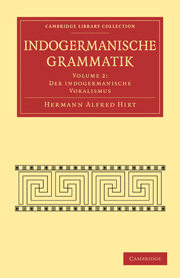Book contents
- Frontmatter
- Vorwort
- Contents
- Einleitung
- Erster Teil. Der Ablaut innerhalb der Silbe
- I Kapitel. Abstufung ei: i usw
- II Kapitel. Mannigfaltigkeit des idg. Vokalismus. Die Vokale e, a, o
- III Kapitel. Die langen Vokale
- IV Kapitel. Die Dehnstufe (D)
- V Kapitel. Die Langdiphthonge
- VI Kapitel. Die Reduktionsstufe (R)
- Zweiter Teil. Der Ablaut mehrerer Silben
- Dritter Teil. Ergänzende Fragen
- Wörterverzeichnis
- Umschreibung
- Abkürzungen
- Berichtigungen
I - Kapitel. Abstufung ei: i usw
Published online by Cambridge University Press: 05 February 2015
- Frontmatter
- Vorwort
- Contents
- Einleitung
- Erster Teil. Der Ablaut innerhalb der Silbe
- I Kapitel. Abstufung ei: i usw
- II Kapitel. Mannigfaltigkeit des idg. Vokalismus. Die Vokale e, a, o
- III Kapitel. Die langen Vokale
- IV Kapitel. Die Dehnstufe (D)
- V Kapitel. Die Langdiphthonge
- VI Kapitel. Die Reduktionsstufe (R)
- Zweiter Teil. Der Ablaut mehrerer Silben
- Dritter Teil. Ergänzende Fragen
- Wörterverzeichnis
- Umschreibung
- Abkürzungen
- Berichtigungen
Summary
4. Ablaut, Abstufung, Abtönting. In alien indogermanischen Sprachen zeigt sich in etymologisch zusammenhängenden Wörtern ein Vokalwechsel. So finden wir im Deutschen binde, band, gebunden; werde, ward, geworden; fliehe, floh; steige, stieg, im Griechischen οἰδα, ἰδεῖν, εἰδέω; ἐλεύσομαι, ἤλυϑον, ἐλήλουϑα, im Lateinischen fŭgio, fūgi, precor, procus usw. Wollte man alle Fälle des Vokalwechsels für das heutige Deutsch zusammenstellen, so erhielte man eine sehr große Anzahl verschiedener Arten. Sie sind in den älteren deutschen Grammatiken verzeichnet. In einer Reihe von Fällen ist ein Vokalwechsel erst im Laufe der Sprachgeschichte aus deutlich erkennbaren Ursachen entstanden; so geht z. B. der Wechsel a : e im Deutschen häufig auf die Einwirkung eines i oder j zurück, durch das a in e verwandelt wurde, z. B. Vater : Väter, Hand : behende. In anderen Fällen liegen Angleichungen vor und ähnliches, z. B. geworden : wurden. Sammelt man diese Erscheinungen, so bleiben immer noch viele Fälle übrig, die jeder Erklärung trotzen, und die daher, wie wir annehmen müssen. schon in vorgeschichtlicher Zeit entstanden sind. Diese Erscheinung nannte Jak. Grimm mit einem neu geschafienen Ausdruck Ablaut, und dieser Name ist so fest eingebürgert, daß man ihn nicht wird beseitigen wollen. Ist er doch sogar ins Englische gedrungen.
- Type
- Chapter
- Information
- Indogermanische Grammatik , pp. 4 - 17Publisher: Cambridge University PressPrint publication year: 2009First published in: 1921



